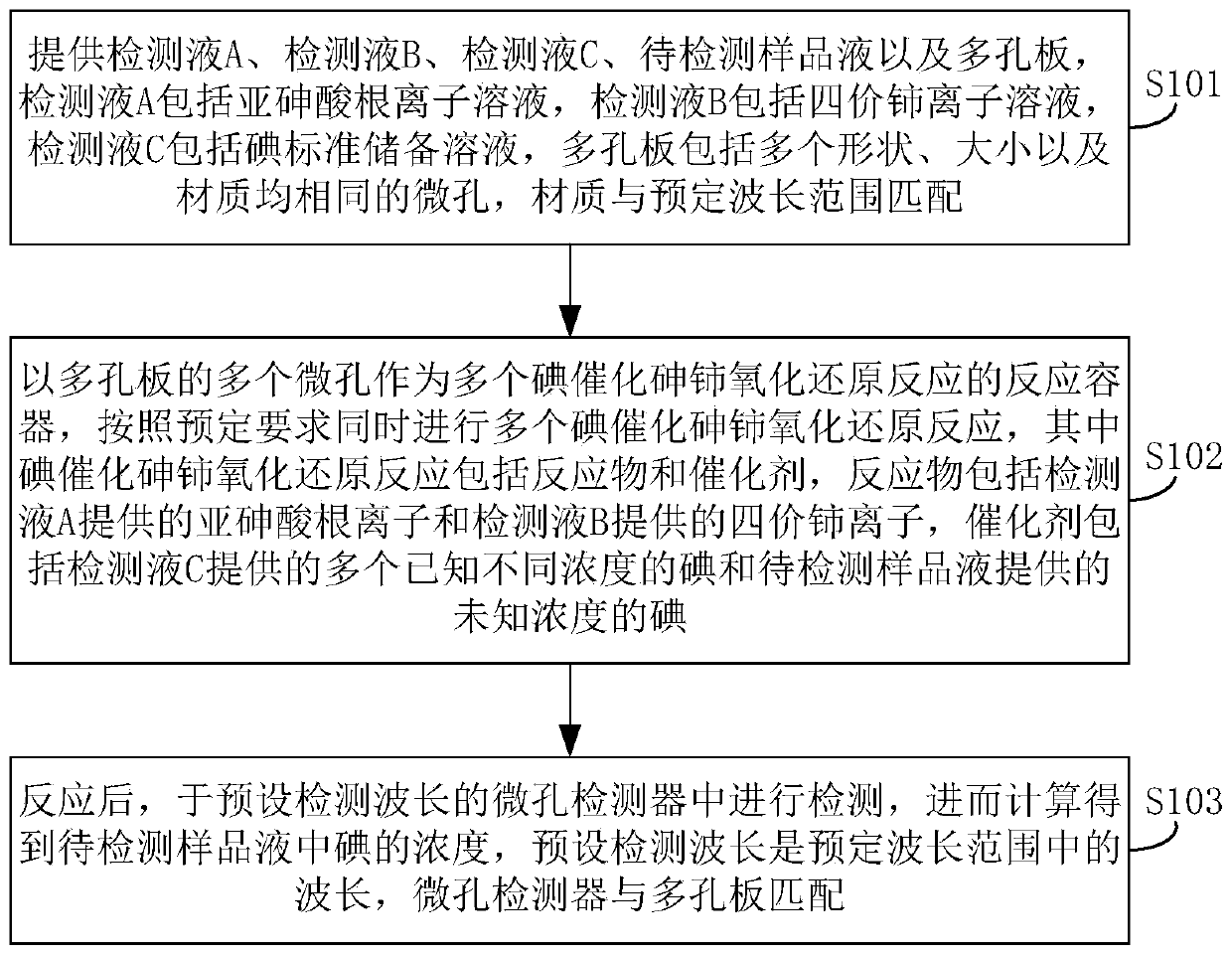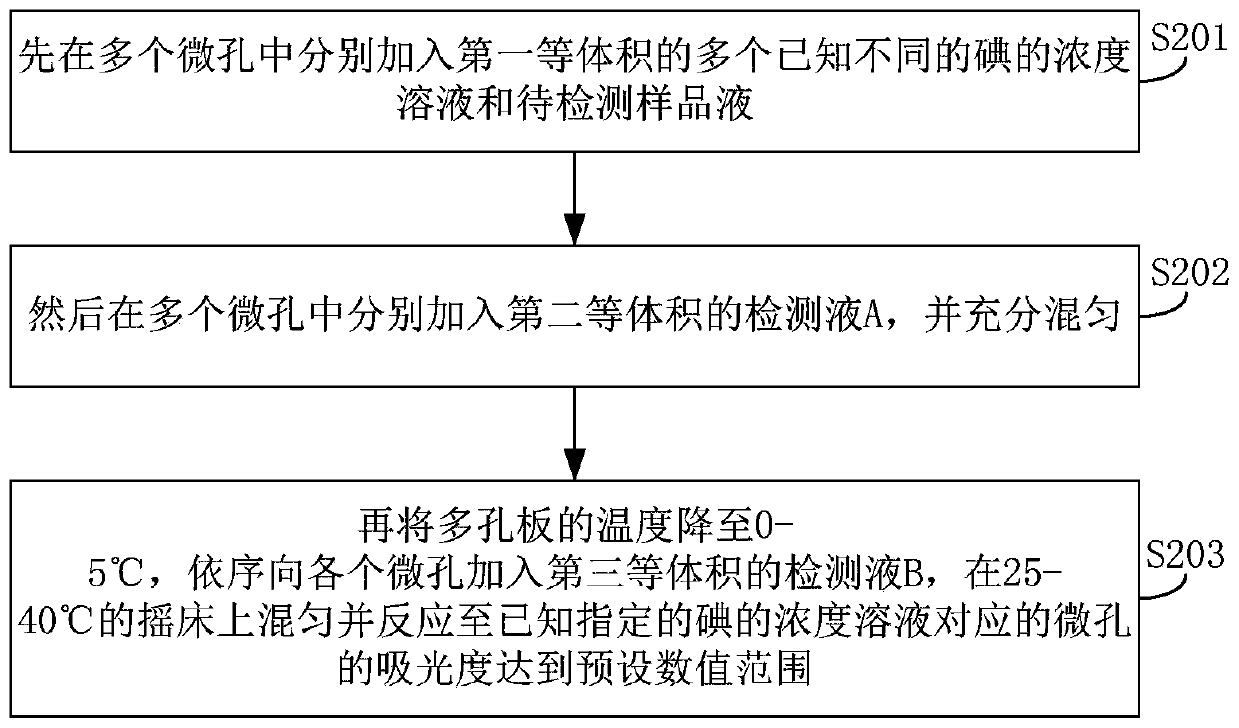Method for detecting iodine concentration
A technology of iodine concentration and concentration, which is applied in the field of chemical detection, can solve the problems of a large amount of waste liquid containing arsenic, which is difficult to popularize and use, and difficult to purchase reagents, and achieves the effects of small micropore volume, automatic operation, and small amount of catalyst
- Summary
- Abstract
- Description
- Claims
- Application Information
AI Technical Summary
Problems solved by technology
Method used
Image
Examples
Embodiment 1
[0070] In this embodiment, the sample with a known concentration of 50.9±2.3 μg / L is used as the test solution 1 (ie, the sample to be tested), and 8 main wells are used as the standard curve test series, and 24 auxiliary wells are used to detect the test solution 1.
[0071] (1) Preparation of detection solution: preparation of detection solution A, detection solution B, detection solution C and iodine standard intermediate solution with a concentration of 300 μg / L;
[0072] Wherein, detection solution A is arsenous acid solution (c(H 3 AsO 3 )=0.06mol / L): 0.6g of arsenic trioxide, 4g of sodium chloride and 0.2g of sodium hydroxide plus 50mL of pure water, heated to dissolve and then cooled to room temperature. Slowly add 20mL, 2.5mol / L sulfuric acid solution, cool to room temperature, dilute to 100mL with pure water, store in a brown bottle, and store at room temperature for 6 months.
[0073] Detection solution B is ammonium cerium sulfate solution (c(Ce 4+ )=0.025mol / L)...
Embodiment 2
[0092] In this embodiment, a sample with a known concentration of 50.9±2.3 μg / L is used as the test solution 2, 8 main wells are used as the standard curve test column, and 24 auxiliary wells are used to test the test solution 2.
[0093] (1) Take out the preparation of the iodine standard intermediate solution that is 300 μg / L of detection solution A, detection solution B, detection solution C and concentration;
[0094] Immediately before use, draw 30 μL of detection solution C into a 10 mL constant volume tube, and dilute to the mark with pure water to obtain a 300 μg / L iodine standard intermediate solution.
[0095] Take the liquid with a concentration of 5.09±0.23mg / L obtained by diluting the environmental standard sample, take 100.0μL of the liquid and place it in a 10mL constant volume tube, and dilute to the mark with pure water to obtain a test solution of 50.9±2.3μg / L two.
[0096] (2) Sample addition:
[0097] A. Select 8 wells in a 96-well plate as the main wells...
Embodiment 3
[0113]In this embodiment, a sample with a known concentration of 124±12.4 μg / L was used as the test solution 3, 8 main wells were used as the standard curve test column, and 24 auxiliary wells were used to detect the test solution 3.
[0114] (1) Take out the preparation of the iodine standard intermediate solution that is 300 μg / L of detection solution A, detection solution B, detection solution C and concentration;
[0115] Immediately before use, draw 30 μL of detection solution C into a 10 mL constant volume tube, and dilute to the mark with pure water to obtain a 300 μg / L iodine standard intermediate solution.
[0116] Take the solution of the environmental standard sample, accurately draw 0.2mL, and dilute it into a 10mL constant volume tube to obtain the test solution 3 with a concentration of 124±12.4gμg / L.
[0117] (2) Sample addition:
[0118] A. Select 8 wells in a 96-well plate as the main wells, add 75 μL of iodine standard intermediate solution with a concentrat...
PUM
| Property | Measurement | Unit |
|---|---|---|
| wavelength | aaaaa | aaaaa |
| coefficient of variation | aaaaa | aaaaa |
Abstract
Description
Claims
Application Information
 Login to View More
Login to View More - Generate Ideas
- Intellectual Property
- Life Sciences
- Materials
- Tech Scout
- Unparalleled Data Quality
- Higher Quality Content
- 60% Fewer Hallucinations
Browse by: Latest US Patents, China's latest patents, Technical Efficacy Thesaurus, Application Domain, Technology Topic, Popular Technical Reports.
© 2025 PatSnap. All rights reserved.Legal|Privacy policy|Modern Slavery Act Transparency Statement|Sitemap|About US| Contact US: help@patsnap.com



